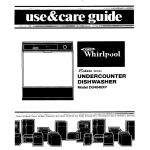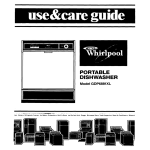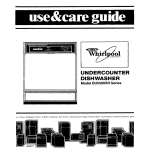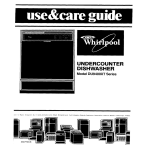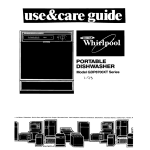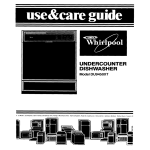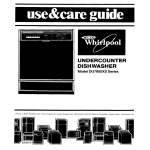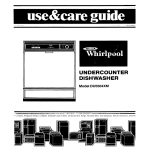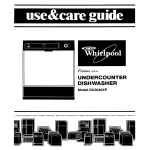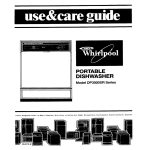Download CONVERTIBLE/ PORTABLE DISHWASHER
Transcript
CONVERTIBLE/ PORTABLE DISHWASHER Model GDP6000XR Series \-93 reezers. Refrigerator-Treezerr. Ice Makers, Dishwashers. Bull-In Ovens and Surlace Un~ls. Ranges. MIcrowave Ovens, Trash Compactors, Room Air Condltloners, Dehumldlfll Contents BEFORE YOU USE YOUR DISHWASHER IMPORTANT SAFETY INSTRUCTIONS.. PARTS AND FEATURES.. POWER CLEAN’ WASHING SYSTEM. Quiet Operating Tips PROPER LOADING Top Rack Loading Bottom Rack Loading Silverware Basket Loading ADDING DETERGENT.. RINSE AID DISPENSER.. BEFORE STARTING YOUR DISHWASHER STARTING YOUR DISHWASHER.. Paw 01986 Whirlpool Changing a Setting To Add a Dish After Starting Selecting a Cycle.. HI-TEMP WASHING Option The AIR DRY Option The RESETOPTIONS Button ENERGY SAVING TIPS SPECIAL TIPS COMMON DISHWASHING PROBLEMS, CONNECTING YOUR DISHWASHER.. IF YOU NEED SERVICE OR ASSISTANCE. Corporation Page i 9 9 9 10 10 11 12 14 15 ‘Tmk. Before you use your dishwasher It is your personal responsibility and obligation to be sure your dishwasher Is installed by a qualified installer. l Has been installed where it is protected from the elements. l Has been installed on a floor strong enough to support its weight. l Has been properly connected to electricity, water and drain.* l Has been properly electrically grounded.* l Is not used by children or anyone unable to operate it properly. l Is properly maintained. *See installation instructions for complete information. l Parts and features Model GDP6000XR Series UPPER SPRAY ARM TOP RACK HOSE CONNECTOR [not shown] BOTTOM RACK RACK BUMPER fl DETERGENT DISPENSER [ :. .--., MODEL AND SERIAL w NUMBER PLATE SILVERWARE BASKET \ RINSE AID DISPENSER yg& - LOWER SPRAY ARM HE OVERFLOW PROTECTOR is designed to prevent too much water from entering the dishwasher. It is not removable. I \I DOOR AND ACCESS COLOR PANEL PACK 1 I THE POWER CLEAN* MODULE is designed to keep the wash and rinse water clean. It also grinds up and removes food particles. During grinding, some sounds will be heard. Tmk I Copy your Model and Serial Numbers When you need service or call with a question, have this information ready. 1. Complete Model and Serral Numbers (from the plate located as shown). 2. Purchase date from sales slip. Copy this information In these spaces. Keep this book, your warranty and sales slip together in a handy place. here.. . Model Serral Number Number Purchase note Service Company and Telephone Number POWER CLEAN”’ Washing System Your dishwasher cleans by spraying a mixture of hot, clean water and detergent against soiled surfaces of dishes, When a cycle is started,the dishwasher fills with Water to about the level of the heating element. This water is pumped through the rotating spray armsthrough the POWER CLEAN Module which removes food particlesand back through the rotating spray arms. Soiled water is pumped out and replaced with clean water during a cycle - the number of times depends on the cycle being used. The POWER CLEAN* Module removes particles from the water, stores them, washes them down the drain. Load dishes so soiled surfaces erful spray from rotating arms. Step-saving preparation face pow- for washing It is not necessary to rinse dishes before putting them into the dishwasher. Just remove large pieces, bones, and other hard items. The POWER CLEAN’ Module will remove food particles from the water. It contains a chopping device which will reduce the size of food items. If hard items such as fruit seeds, nuts and egg shells enter the POWER CLEAN* Module, you Hot water food then might hear chopping, grinding, crunching or buzzing sounds. Those sounds are normal when hard items enter the module. DO NOT LET METALLIC ITEMS (I.E. POT HANDLE SCREWS) GET INTO THE POWER CLEAN* MODULE. THIS COULD RESULT IN DAMAGE TO THE POWER CLEAN’ MODULE. is a must Hot water dissolves and activates the dishwashing detergent. Hot water dissolves grease on dishes and helps dry glasses spot-free. Make certain loads are washed in hot water (at least 140°F - 60°C). Two ways to have a reliable hot water supply... I. Maintain 140°F water supply at central water heater. To check water temperature, turn on hot water faucet nearest the dishwasher. Let water run until it is as hot as possible, then check with a candy or meat thermometer. If the temperature is too low, have a qualified person raise the water heater thermostat setting. 2. Use HI-TEMP WASHING Option. If water heating is needed, a thermostat will delay the cycle until temperature reaches 145°F (63°C). If water is hot enough, the cycle will proceed with no delay. This lets you turn down your water heater, if you choose, without cutting back on hot water needed for good dishwashing. Quiet operating tips To avoid thumping and clattering noises during operation: l Make sure light weight load items are secured in the rack. l Make sure pot lids and handles, pizza pans, cookie sheets, etc. do not touch interior walls 4 or interfere with either of the spray arms rotation. l Load dishes so they don’t touch one another. NOTE: Keep sink drain plugs inserted during dlshwasher operation to prevent noise transfer through drains. ‘Tmk. Proper loading Always load dishes so soiled surfaces are reached by spray from rotating Water must be able to drain off completely for best drying results. Be careful items so spray can reach all surfaces spray arms. to Separate Top rack loading The top rack is designed for cups. glasses and smaller items. l Place so open ends face down for cleaning and draining. l load glasses in top rack only. Bottom rack is not designed for glasses. Damage may occur. f l l l l MIXED LOAD Load plastic items only in the top rack. Only plastic items marked “dishwasher safe” are recommended. Plastic items can be melted in the bottom rack. l Place items in the rows between prongs. Placing them over the prongs can lead to breakage. Be sure lightweight items are held firmly in place. China, crystal and other delicate items must’not touch another item during dishwasher operation. Damage may occur. l Items with cooked-on soiled surfaces facing or dried-on the spray. foods l Small bowls, pans and other utensils can be placed in the top rack. should be loaded in the bottom rack with 5 Bottom rack loading Silverware basket loading Load torks and spoons so they don’t nest together. Spray can’t reach nested items. NO Make sure pot handles and other items do not stop rotation of either the upper or lower spray arm. Spray arms must move freely. Securely place heavily soiled cookware face down in rack. l l YES Mix items In each section of the basket. Small items - baby bottle caps, jar lids, etc -can be put In any section. Make sure sharp items [knives, forks, skewers, etc.] are put in point down. DI Place plates, soup bowls, etc., between prongs and facing the spray. l The silverware basket can be loaded while it’s in place on the door, or it can be taken out for loading on the counter or table. It can also be removed for easy unloading. Always unload or remove the basket before unloading the racks to avoid spillrng water droplets on the U To remove the basket, slide it toward the top of the door - by the handle. Lift it off the holding buttons. Replace it in reverse order. l Load cookie sheets, cake pans and other large items at sides or back Loading such items in front may keep water spray from reaching detergent dispenser and silverware basket. NOTE: Do not load glasses, cups or plastic items in the bottom rack. l When lower rack is removed, replace with bumpers in front. 6 l To open the basket, as shown. Be sure t cover is complete latched before pulling out the bottom rack and before closing the dishwasher door. unhook the latch Adding detergent The kind and amount of dishwasher detergent you use is an important getting your dishes clean. Read this section carefully. Use automatic dlshwasher detergent only. Other detergents are too mild and much too sudsy to work in the dishwasher. Different brands of dishwasher detergent have different amOUntS of phosphorus. Phosphorus softens water and helps prevent Water spots on dishes. The detergent part of dispenser The detergent dispenser has one section with a cover and one without. l Put detergent in both sections for cycles with two washes. l Put detergent in the covered section only for cycles with one wash. l Push the cover down until it is latched. The cover opens automatically when the main wash starts. Detergent in the open section falls into the dishwasher when the door is closed. If water is hard and phosphorus content is low (8.7% or less), you may need to use more detergent or use a brand with a higher phosphorus content (12% or higher) COVER Do not add detergent until you are ready to wash. Fresh automatic dishwasher detergent is necessary for best washing results. Store detergent tightly in a cool dry place. COVER LATCH J Use covered section for... NORMAL WASH Cycle LOW ENERGY WASH Cycle How much detergent 1’ Use both sections for.. POTS & PANS Cycle HEAVY WASH Cycle to use The amount of detergent to use depends on the hardness of your water. If too little is used, dishes won’t be clean. However, if too much is used in soft water, glassware will begin to etch. Find out your water’s hardness by asking your local water department, water softener company or county extension agent. l l l HARD - Fill 1 or both sections to top line if water is 8 or more grains of hardness. MEDIUM - Fill 1 or both sections to middle line if water is 5 to 7 grains of hardness. SOFT - Fill 1 or both sections to bottom line if water is 0 to 4 grains hardness. of Rinse aid dispenser A rinse aid helps keep water from forming droplets and drying as spots. Keep the dispenser filled with a rinse aid such as Jet-Dry.@A small amount is released automatically during the final rinse of each cycle. Check the dispenser periodically to see if it needs refilling. Keep the dispenser fill cap tightly closed, Before starting your dishwasher c 1. Spin the Upper Spray Arm to make sure nothing will stop it from turning freely 2. Push door firmly when closing and it will automatically latch. 3. Run hot water at sink nearest dishwasher until it is hot. Turn it off. See page 14 for connecting instructions. CLEAN SELECTOR BUTTONS OPTION SELECTOR BUTTON! Starting your dishwasher POTS & PANS cycle... HEAVY WASH cycle... 1. Push POTS & PANS Clean Selector Button. 2. Push button for option desired. 3. Turn Cycle Control Knob clockwise to dot marked POTS & PANS. - POTS & PANS and HEAVY WASH Cycles share the same spot on the dial. The Clean Selector Button determines which cycle operates. The dishwasher will automatically start that cycle. 1. Push HEAVY WASH Clean Selector Button. 2. Push button for option desired. 3. Turn Cycle Control Knob clockwise to dot marked HEAVY WASH. - HEAVY WASH and POTS & PANS Cycles share the same spot on the dial. The Clean Selector Button determines which cycle operates. The dishwasher will automatically start that cycle. NORMAL WASH cycle... LOW ENERGY WASH cycle... 1. Push NORMAL WASH Clean Selector Button. 2. Push button for option desired. 3. Turn Cycle Control Knob clockwise to dot marked NORMAL WASH. The dishwasher will automatically start that cycle. 1. Push NORMAL WASH Clean Selector Button. 2. Push button for option desired. 3. Turn Cycle Control Knob clockwise to dot marked LOW ENERGY WASH. The dishwasher will automatically start that cycle. RINSE 81 HOLD cycle... 1. Push NORMAL WASH Clean Selector Button. 2. Select AIR DRY Option only. 3. Turn Cycle Control Knob clockwise to dot marked RINSE & HOLD. The dishwasher will automatically start that cycle. Changing a setting You can change a setting anytime during any cycle. 1. Press in the door latch to unlatch the door and stop the cycle. To add a dish after starting 1. To be sure the added item is washed and rinsed, make sure the Cycle Control Knob has not passed LOW ENERGY WASH. 2. Unlatch the doorto stop the cycle. 3. Open the door and add the dish. 8 2. Turn the Cycle Control Knob clockwise to the cycle you want. 3. Be sure the detergent dispensers are filled properly for the new cycle. 4. Close and latch the door, The dishwasher will automatically start the new cycle. 4. Close the door. Do not latch It. Wait 30 seconds for air in the dishwasher to warm up. This helps reduce the amount of moisture that can come from the vent when restarting the cycle. 5. Latch the door. The dishwasher will start from where it stopped. CYCLE CONTROL KNOB Selecting a cycle POTS 81PANS Cycle Maximum cleaning for cookedor baked-on foods. Timer delays while the dishwasher automatically heats the water to 145-F (63-C) in both washes and the last rinse (marked ‘1, Cycle time will be about I’/2 to 2 hours, depending on time needed to heat water. HEAVY WASH Cycle A double wash for heavily soiled loads. Cycle time is about 60 minutes. NORMAL WASH Cycle For normal, everyday soiled loads, [The Energy Guide Label data is based on this cycle.) Cycle time is about 55 minutes. LOW ENERGY WASH Cycle For pre-rinsed loads. Cycle minutes. or lightly soiled time is about 50 RINSE & HOLD Cycle For rinsing a few items to be washed one or more days later. Cycle time is about 10 minutes. Use AIR DRY only. Do not use HI-TEMP WASHING Option. HI-TEMP WASHING Option When this option is selected, water for the main wash and the final rinse is heated tol45” F (63” C). Washing and rinsing action in those parts of the cycle will be longer if the water is heated. HI-TEMP washing is automatic in POTS & PANS. The AIR DRY Option save energy, but dishes take longerto dry [Overnight) and some water spotting may result. Some items (such as plastics] may need towel drying. Air in the dishwasher is automatically heated during the “dry” part of all cycles. If the AIR DRY Option is selected, air in the dishwasher is not heated. Using this option helps For best results, use a liquid Jet-Dry? rinse aid such as 9 The RESET OPTIONS Burton If you want to change a selected option, push the RESET OPTIONS Button Re-select an option, if desired. Energy saving tips You can help save energy if You: 1. Wash full loads. Running a half-filled dishwasher uses the same amount of electricity and hot water as a fully loaded machine. 3. Air dry dishes drying cycle. (overnight) when you don’t need a rapid Allow longer drying times 2. Use the LOW ENERGY WASH Cycle whenever possible. It uses less hot water and energy than other wash cycles. 4. load correctly for best washing results. Incorrect loading may cause poor washing and the need to rewash all or part of the load. normally soiled dishes. Se5. Don’t pre-rinse lect the correct cycle for the load and use the recommended amount of detergent for good washing results without hand rinsing. 6. Use your dlshwasher during off-peak hours. Local utilitres recommend this to avoid heavy usage of energy at certain times of day can be done quickly and 7. Kitchen cleanup efficiently through the use of your dishwasher. Most appliance parts that can fit in the dishwasher can be cleaned by it. Burned-on soil, however, should be cleaned by hand. Special tips on dishwasher use Remember, use your dishwasher only for the job it was designed to do. Some items are not dlshwasher safe or may require special care. Read these special tlps for the following items: AhUUiUUUl: Aluminum loses its bright, shiny appearance and darkens in color due to minerals in the water and the alkalinity of the dishwasher detergent. Colored aluminum may fade. TIPS: If washed in the dishwasher avoid placing directly in front of detergent dispenser where it could be sprinkled with undissolved detergent, causing spotting, pitting, and discoloration. Follow utensil manufacturers’ cleaning instructions. China: Hand-painted, metal-trimmed, and antique china may fade due to high water temperatures and alkaline detergent solution in the dishwasher. TIPS: Delicate, antique items should not be washed in the dishwasher. Load carefully. Do not allow pieces to touch each other. Test one piece by washing it daily in the dishwasher for several weeks, Then compare it with the rest of the set to see if colors have changed. and decorative cQ%td gasses: Crystal can break from sudden exposure to high water temperature, Metal trim and colorful decoration on glass will fade in time when washed in the dishwasher. TIPS: Delicate, antique items should not be washed in the dishwasher. Load carefully in top rack only. Be sure to load a few larger items in the bottom rack to reduce amount of force of water spray reaching glassware from lower spray arm. Use the shortest cycle. Flatware: Salty and acidic foods may tarnish silver and stainless flatware if allowed to remain on the utensils. A film may form on sterling silver and silver plate items washed in a dishwasher, This film is caused by reaction of silver with chlorine in the detergent. Gold flatware is not dishwasher safe. TIPS: Rinse flatware as soon as possible, especially if it is not to be washed right away. Dishwasher detergent may remove antique finishes. Wash by hand. Tarnish and film build-up can be removed with silver polish. $$+&OlI UteUSik The seasoned TIPSI Wash by hand. To re-season, hour or two. finish will be removed coat with unsalted in the dishwasher. Rusting fat and heat in a slow oven for an Plastics: Many plastics will have “Dishwasher Safe” written on them. Some plastics heat sensitive and may melt or warp. TIPS: If in doubt, try one piece. Place in upper rack only. AIR DRY option provides additional protection. Non-stick finish utensils: TIPS: Follow manufacturers’ Most can be washed suggestions. are in the dishwasher. Wood: Many wooden items will crack and warp or lose their finish. TIPS: Do not wash cutting boards, wooden salad bowls or knives dles In the dishwasher. with wooden han- Pewter or pewter-like TIPS: To keep pewter IllateI’ialS: May streak, discolor, and pit. at its very best, hand wash with mild detergent. Dishwasher care & cleaning: Exterior - Regular use of a soft damp cloth or sponge and a mild detergent is all that is necessary, in most cases, to keep the outside of your dishwasher nice looking and clean. Interior - Hard water minerals may cause a white film to build-up on the inside surfaces, especially just beneath the door area. Wear rubber gloves when cleaning the dishwasher interior. Do not use any type of cleanser other than dlshwasher detergent because It may cause foaming or sudsing. 11 Common dishwashing PROBLEM CAUSED BY SOLUTION Spottlng and fllmlng (hard water film] Hard water Fill detergent tergent with be necessary Water is not hot enough Not enough detergent, or Improper detergenl “Old” detergent Improper loading AIR DRY Settrng Small partlcles deposlted on Items used deMav To remove spots and film, try a vinegar rinse.. 1. Wash and rinse load as usual. Use AIR DRY. 2. Remove all metal items. 3. Put 2 cups (500 mL) white vinegar in a container on the bottom rack. 4. Run dishwasher through a complete washing cycle. Water temperature should be at least 140°F (60°C) Set water heater thermostat to a higher setting. Run water at sink until hot before starting and/or use HI-TEMP WASH Option Use more dishwasher detergent Use detergent with highest available phosphorus content. .especially with hard water. Use only tresh dishwasher detergent. Store tightly closed container, in cool, dry place. Discard old detergent. Do not fill dispensers until ready to start dishwasher. Make sure dishes and glassware are loaded so spray reaches all surfaces and items drain properly. Do not overload Do not nest Items Drying without and silver. heat may result in some spotting of glasses Spray arm or arms not rotating freely Check spray arms to make sure they turn freely after ing. Be sure a utensil has not prevented their turning. “Old” Use only fresh dishwasher detergent. Store tightly container, in cool, dry place. Discard old detergent, fill dispensers until ready to start dishwasher. detergent loadclosed Do not Not enough detergent, or Improper detergent Use more dishwasher detergent. Use detergent est available phosphorus content .especially water. Water IS not hot enough Water temperature should be at least 140-F (6O’CJ. Set water heater thermostat to a higher setting. Run water at sink until hot before starting and/or use HI-TEMP WASH Optron If water pressure is low, do not use water for other purposes IS running [to assure correct fills). whtle dishwasher Water pressure may be low, dishwasher IS not filling properly Dishes not washlng clean dispensers to capacity Use dishwasher highest avallable phosphorus content. to install water Softener Make sure large items do not block spray from reaching detergent dispensers Does the rinse aid dispenser need filling? See instructions on page 7. No rinse aid with hrghwith hard Water is not hot enough Water temperature should be at least 14O’F (60°C). Set water heater thermostat to a higher setting. Run water at sink until hot before starting and/or use HI-TEMP WASH Optron Improper Spray arm or arms not rotating freely Make sure dishes and glassware are loaded so spray reaches all surfaces and items drain properly Do not overload Do not nest items. Make sure large items do not block spray from reaching detergent dispensers. Check spray arms to make sure they turn freely after loading. Be sure a utensil has not prevented theirturning. Not enough or improper detergent Use more dishwasher detergent Use detergent est available phosphorus content. especially water. loading detergent “0ld”detergent. Water pressure may be low, dishwasher is not filling properly 12 problems with highwith hard Use onlv fresh dishwasher detergent. Store tightly closed container. in cool. dry place. Discard old detergent. Do not fill dispensers Until ready to start dishwasher, If water pressure IS low, do not use water for other purposes while dishwasher is running (to assure correct fills). PROBLEM CAUSED BY SOLUTION Dishes Water is not hoi enough Water temperature should be at least 140°F (60°C). Set water heater thermostat to a higher setting. Run water at sink until hot before starting and/or use HI-TEMP WASH Option Make sure dishes and glassware are loaded so spray reaches all surfaces and items drain properly. Do not overload. Do not nest Items Fill rinse aid dispenser. not dry Improper loading No rinse aid AIR DRY Setting Black marks dishes Chlpplng breaking glassware on or used Allow more time when using AIR DRY Option, DRY. Plastic items may need towel drying. or use HEAT Aluminum utensils rubbing against items during washing Use care In loading alumlnum utensils, especially lightweight toll containers. Place so they do not touch dishes. Remove black marks with plastic scouring pad and a mild abrasive cleanser. Improper Do not overload. Load glasses in the top rack only. Load between prongs, not over them. Glasses loaded over prongs will not be supported and may chip or break. loading Cloudy film on glassware, etching permanent corrosion loo much detergent in soft water Check for rainbow hue on glasses. A rainbow hue is the first sign of etching [corrosion of glass). Reduce the amount of dishwasher detergent Use a detergent with a lower phosphorus content Inadequate If water pressure is low do not use water for other purposes while dishwasher is running (to assure correct water fills]. Make sure dishes and glassware are loaded properly to assure adequate rinsing and draining. Do not overload. Dishes 81 lnterlor of dlshwasher yellow or brown Iron or manganese water Rust spots on stalnless steel -ORDark spots on tlatware stalnless steel, sliver plate, or sterling Allowing salty or acidic foods such as mayonnaise, vinegar, fruit juices, salad dressings, milk products to remain on flatware. Undissolved detergent coming in contact with flatware Bronze tarnish on sllverplate Water left in bottom ot dlshwasher rinsing in Temporary remedy: 1 Set empty dishwasher for a “one wash”cycle. 2 Start dishwasher and unlatch door to stop it when it has filled for the wash part of the cycle. 3. Add % to 1/2 cup (120 to 240 ml) of citric acid crystals (usually avallable In drugstores). 4 Close and latch door to complete cycle. Permanent solution: Install an iron or manganese filter to home water supply Rinse flatware that is to stand for several hours before washing (use Rinse &I Hold). Clean stained items with silver polish and re-wash. Do not put stalnless steel and sliver tlatware In the same sllverware basket compartment. Direct contact between these metals can cause permanent damage to the sliver. Remove spots with silver polish. Avoid spilling detergent on wet flatware. concentrated Silverplate is worn off Exposed base metal to kes on a bronzed hue. Remove replated Dishwasher cycle not completed Clogged drain air sap Allow tarnish dishwasher with silver polish. to complete Have silver cycle Some plumbing codes require use of a drain air gap between an undercounter dishwasher and the drain system of the house. The air gap is usually located above the sink or on the top of the counter near the dishwasher to prevent the possibility of water backing up from the drain into the dishwasher due to a plugged drain. The drain air gap is NOT a part of the dishwasher and is NOT covered by the dishwasher warranty. The drain air gap should be kept clean to insure proper draining of the dishwasher 13 Connecting your portable A special adapter must be installed be connected. Complete instructions dishwasher. When moving your the door is latched. dishwasher, make sure dishwasher on the faucet before the dishwasher can are packed with your and the adapter while pull3. Lift slightly on the hose connector ing down the locking collar. Pull down on the connector. 4. Empty any remaining water from the connector. 5. Unplug power supply cord and return to storage compartment. 6. Return hoses to storage compartment. Electrical Before starting Run water at faucet until it is hot. Turn it off. PULL RING Pull hoses out oftheir on the back. storage compartment LOCKING COLLAR L HOSE CONNECTOR / 3. Pull down on the locking collar while lifting the hose connector onto the faucet adapter. snaps into place, re4. When the connector lease the locking collar. 5. Turn the hot water on slowly until it is all the way on. 6. Plug in power supply cord. 7. See pages 8 and 9 to start the dishwasher. While dishwasher is running You can draw water from the faucet while the dishwasher is connected. DO NOT draw water while the dishwasher is filling or while water is being pumped out. [This helps prevent a low fill when dishwasher is filling, or mixing drain water with fresh water.] 1. Press red button on the water you want. Adjust faucet for the 2. Be sure you return that hot water is full hose connector to get (The faucet is set on hot. water you want.) cold water to off, and on. When cycle is finished 1. Turn hot water off (This can be done after the last rinse.] 2. Press the red button on the connector to release the water pressure. 14 Connection A power supply of 120 volts, 60 Hz or110 volts, 50 Hz, AC only, 15 amps, is required. For your personal safety, this appliance must be grounded. This appliance is equipped with a power supply cord having a 3-prong grounding plug. To minimize possible shock hazard it must be plugged into a mating J-prong grounding type wall receptacle, grounded in accordance with the National Electrical Code and local codes and ordinances. If a mating wall receptacle is not available, it is the personal responsibility and obligation of the customer to have a properly grounded 3-prong wall receptacle installed by a qualified electrician. DO NOT use an extension cord. Power Supply Cord DO NOT, UNDER ANY CIRCUMSTANCES, REMOVE THE POWER SUPPLY CORD GROUND PRONG. Converting to built-in Your Whirlpool Portable Dishwasher can be converted to a built-in (undercounter) model by using conversion kit No. 569056. The kit is available at your Whirlpool dealer or authorized TECH-CARE’ Service Company. Instructions are included with the kit. Caring for simulated wood top The simulated wood top can be used as a utility work surface for most kitchen jobs. It is stronger and more easily cleaned than genuine wood. The top can be used as a cutting board. Knife marks will be visible but will not seriously damage top. Hot items from the oven can be placed on the top Clean with warm, soapy water. For dried on foods, use a scouring pad. If you need service or assistance, we suggest you follow these five steps: 1. Before calling for assistance... Performance problems often result from little things you can find and fix yourself without tools of any kind. If dishwasher won’t run, or stops during a cycle: l Is door tightly closed and securely latched? l Has the cycle been correctly set? l Is water turned on? l Have you checked your home’s main fuses or circuit breaker box? l Is the power supply cord plugged into a live circuit with the proper voltage (portable models]? l Has electrical power been interrupted? l lfthe motor has stopped because of an overload, it will automatically reset within a few minutes. If the motor does not start, call for service. If your dishwasher seems to run too long: l Are you using POTS & PANS Cycle or HI-TEMP WASHING Option? The dishwasher may be waiting for the water to heat. l Is your household water temperature too low? Low water temperature settings will cause longer dishwasher operating times. If water remains in the dishwasher: Has the cycle completed? If detergent remains in the covered detergent cup: l Is the bottom rack in backwards? (The rack bumpers should be at the front.) l Is the dishwasher detergent fresh? l Is the cycle completed? l If you hear grinding, grating, crunching, buzzing sounds: l A hard object has possibly entered the POWER CLEAN Module. The sound should stop when the object is ground up. 2. If you need assistance or service overseas.. . Contact distributor. your Military Exchange or Whirlpool WHEN YOU RETURN TO THE UNITED STATES Migratory Policy We realize that you’re purchasing a Whirlpool appliance for what may be a temporary stay in a particular area. If you are transferred to the United States and find that your Whirlpool appliance requires service within the warranty period, simply contact a Whirlpool authorized dealer or service agent. All he’ll require is proof of the purchase date of the appliance. Service will be supplied as shown in your printed warranty. 3. If you need assistance in the U.S.*... Call Whirlpool COOL-LINE * service assistance telephone number. Dial free from: Continental U.S. . . . . . . . . . . . . . . (8001 253-1301 Michigan . . . . . . . . . . . . . . . . . . . . . . (8001 632-2243 Alaska & Hawaii . . . . . . . . . . . . . . . (800) 253-1121 and talk with one of our trained Consultants. The Consultant can instruct you in how to obtain satisfactory operation from your appliance or, if service is necessary, recommend a qualified service company in your area. 4. If vou need service in wtheU.S.*... Whirlpool has a nationwide network of franchised TECHCARE” Service Companies. TECH-CARE service technicians are trained to fulfill FRANCHISED SERVICE 1 the product warranty and provide afterwarranty service, anywhere in the United States. To locate TECH-CARE service in your area, call our COOL-LINE service assistance telephone number [see Step 2) or look in your telephone directory Yellow Pages under: L ELECTRlCAL APPLIANCES MAJOR-REPAIRING A PARTS APPLIANCESHOUSEtiOLDMAJOR-SERVICE 8 REPAIR OR WHIRLPOOL APPLIANCES FRANCHISEDTECH-CARESERVICE WHIRLPOOL APPLIANCES FRANCHISEDTECH~CARESERVICE SEHI',(‘E XYZSERVICECO 123MAPLE XYZ SERVICECO 123MAPLE .SERI’fC‘E ~‘OUPA.YlES COMl'.~.~lES 999~9993 399 9399 OR WASHING MACHINES, DRYERS 8 IRONERS-SERVICING WHIRLPOOL APPLIANCES FRANCHISEDTECH~CARE .sEK~lt XYZSERVICECO 123 MAPLE SERVICE ‘6 ~'oMPA.~lt~,~ 999 9999 5. If you have a problem in the U.S.*... Call our COOL-LINE service assistance telephone number (see Step 31 and talk with one of our Consultants, or if you prefer, write to: Mr. Robert Stanley Division Vice President Whirlpool Corporation 2000 US-33, North Benton Harbor, Ml 49022 *If you must call or write, please provide: model number, serial number, date of purchase, and a complete description of the problem. This information is needed in order to better respond to your request for assistance. 15 1 Making your world a little easier. Part No. 304284 01986 Whirlpool Corporation Printed in U.S.A. ? Makers. Dishwashers. Built-In Ovens and Surface Un~ls, Ranges. Microwave Ovens. Trash Compactors, Room AM Condllloners. Dehumldlflers. Automatic Washers. Clothes C
















